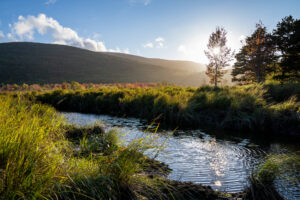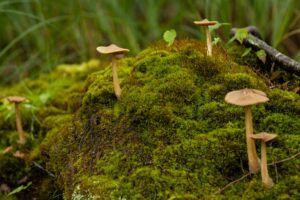By Genie Thorndike
From the Summer 2016 Friends of Acadia Journal
Back in the 1970s, my husband Will and his brother Lanny would count the mountain of an entire summer’s worth of change from the Wild Gardens of Acadia’s collection box on their great-aunt Betty Thorndike’s rug. Today, our family cherishes fond memories of Betty’s early involvement in these gardens, which she helped establish with similarly beloved, creative, and resourceful founders. Every summer we bring family and friends to the Wild Gardens “to sit on Aunt Betty,” which means locating and sitting on the wooden bench that has her name on it. Entering the gardens, we suddenly leave the parking lot noise behind and escape the looming scale of Dorr Mountain. We meander in the green oasis on paths that twist and turn and offer serendipitous choices. Do we move towards the ferns or that rocky ledge? What do the signs Bog or Meadow promise? As we loop and retrace, we each create our own relaxing journey through the thirteen habitats designed to feature the native plants of Acadia National Park.
This season Anne Kozak and Sue Leiter, long-time volunteers in the gardens since the 1970s, celebrate the 55th birthday of the Wild Gardens with their beautifully coauthored pictorial history: The Wild Gardens of Acadia published by Arcadia Publishing. Their selection of historical and current photographs illustrates the evolution of the habitats, and perhaps most importantly pay tribute to the numerous important volunteers who have made and continue to make these spectacular gardens possible.
The founding vision began in 1961 when Janet TenBroeck and members of the Bar Harbor and Mount Desert Garden Clubs decided to learn more about native plants. Energized by then-park superintendent Hal Hubler, who offered the site at Sieur de Monts, Acadia National Park has supported the gardens with steady resources ever since. Devoted, hard-working volunteers have been crucial to the gardens’ success. These loyal stewards source and propagate plants, maintain and develop new habitats, teach visitors about wild flowers, and work hard to ensure the gardens’ perpetuity.
Sue Leiter reflects on the talent: “bright, strong-willed, determined people who had to cooperate to achieve an important goal. The Wild Gardens of Acadia represents an almost miraculous accomplishment achieved and maintained by a group of people whom I greatly admire.” Anne Kozak expresses similar admiration and gratitude: “While a number of people were active in establishing the gardens, some—particularly Betty Thorndike, Janet TenBroeck, Betty Owens, Ruth Goldthwait, Katrina Hummell, Dorcas Crary, and Ruth Soper— turned out not only to be long-term volunteers but extraordinary mentors for me, Sue Leiter, Bobbie Cole, and countless others. From them, committee members learned more than just how to cultivate and maintain plants native to Mount Desert Island.”
Josh Winer, whose contemporary photographs complement the archival images in the book, describes a sentiment probably felt by many: “Anne and Sue enlisted me but the gardens seduced me; the more I learned about the history of stewardship and dedication of the gardens’ founders, the more invested in the project I became, and I felt quite proud to be a contributor.”
Fortunately the future of the Wild Gardens is now assured by coming under the umbrella of Friends of Acadia in 2012 thanks to the efforts of Ken Olson, Lili Pew, Marla O’Byrne, Sheridan Steele, and the staff of Friends of Acadia. Anne Kozak and Sue Leiter worked hard to achieve this protection and are crucial links from the early founders to the current head gardener, interns, and volunteers. Their extensive involvement in all aspects of the gardens makes them uniquely qualified to write this detailed history, from which all royalties will go directly into the new endowment for the Wild Gardens.
Come explore the Wild Gardens on your way into the park, before a hike up Dorr or a visit to the Nature Center or the original Abbe Museum at Sieur de Monts Spring. Afterwards, do purchase a copy of The Wild Gardens of Acadia to learn about its history. And I invite you “to sit on Aunt Betty” or any of the other well-placed benches commemorating individuals instrumental in creating and caring for this Acadia National Park treasure. ❈
GENIE THORNDIKE has volunteered in the Wild Gardens of Acadia since 2010 and currently serves on the WGA Executive Committee. Residents of Bar Harbor and Westwood, Massachusetts, Genie and Will have been members of Friends of Acadia for more than a decade.
Photo: This archive photo appears in The Wild Gardens of Acadia with the caption, “By the spring of 1963, the native columbine (Aquilegia canadensis) that Elizabeth Thorndike grew from seed was ready to be planted on the Mountain, a habitat displaying plants that grow naturally at higher elevations. To ensure its survival, Thorndike regularly watered it, setting an example of stewardship for future volunteers.”

The Wild Gardens of Acadia
By Anne M. Kozak and Susan S. Leiter
Arcadia Publishing & The History Press / Images of Modern America series
ISBN: 9781467115278 $22.99
160 pp. full-color paperback
About the Authors
ANNE KOZAK began volunteering in the Wild Gardens of Acadia in 1973 and is currently the co-chair of the Wild Gardens Committee. A freelance writer and editor, Kozak teaches writing and directs the writing program at College of the Atlantic in Bar Harbor.
SUSAN LEITER has volunteered in the Wild Gardens of Acadia since 1974, and served as co-chair for 22 years. She is retired from a long career as the library media specialist at Conners Emerson School in Bar Harbor, where the library bears her name.
“Few of the thousands of park visitors that tour the garden each year have any inkling of just how much of a struggle it has been to create and continue the effort. A brief chapter outlining the history is included in ‘The Wild Gardens of Acadia.’ But the most fertile ground is in the pictures. The images are more than a simple look back. They serve as a roll call of the personalities, talents and sacrifices that have kept the garden going, as well as a casual guide to the plants and trees themselves. The beauty of it all is that it demonstrates the truism that when it comes to nurturing a garden, even a ‘wild’ one, the growth of people, plants and knowledge is inextricably intertwined.” —Mount Desert Islander
Author events for The Wild Gardens of Acadia
July 25 at College of the Atlantic
August 24 at Northeast Harbor Library
 Join
Join Donate
Donate Acadia National Park
Acadia National Park


